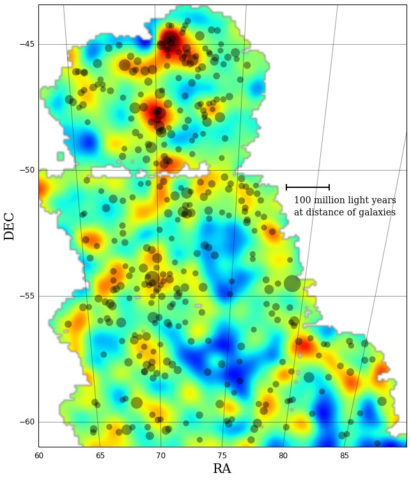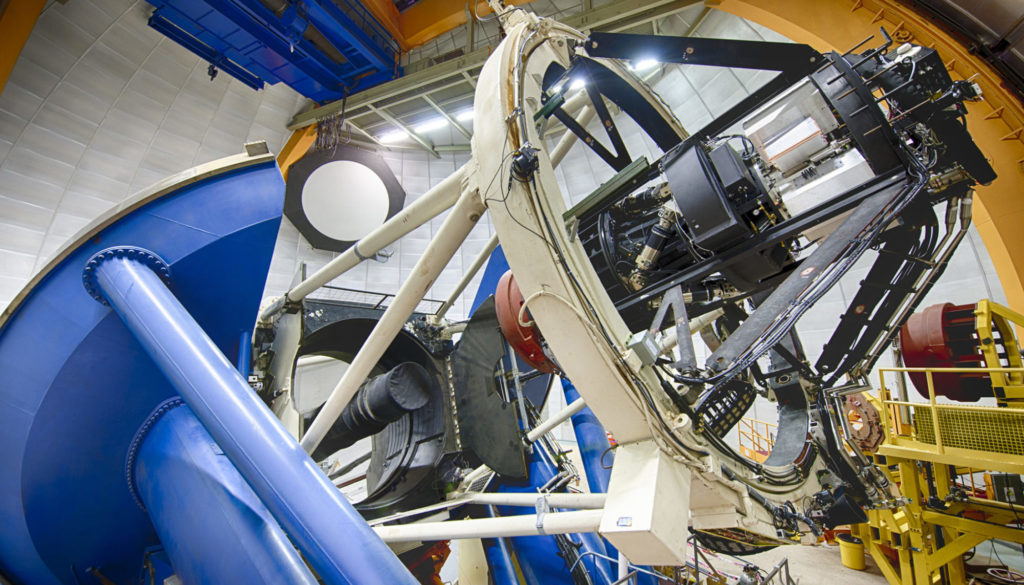Dark Energy Survey Creates Detailed Guide to Spotting Dark Matter
Dark Energy Survey (DES) scientists, including astronomers at Texas A&M University, are celebrating the release of the first in a series of dark matter maps of the cosmos.
The new map, released today (April 13) at the American Physical Society April 2015 Meeting in Baltimore, Md., was created using data captured by the Dark Energy Camera (DECam), the 570-megapixel imaging device and primary instrument for DES for which Texas A&M astronomer Darren DePoy served as the project scientist. The map reflects early DES observations and covers only about 3 percent of the total area of sky DES will image during its five-year mission, which runs through 2018.
As the largest contiguous maps created at this level of detail, each subsequent map in the overall DES series is expected to improve scientists’ understanding of dark matter’s role in the formation of galaxies. Analysis of the clumpiness of the dark matter in the maps also will allow them to probe the nature of dark energy, which is believed to be causing the expansion of the universe to speed up.
As fulfilling as the first tangible map-related results are, DePoy says the fundamental victory behind such unprecedented scenes also is well worth noting and celebrating.


“The big news that’s difficult to explain in a news announcement is that DECam/DES is able to make these kinds of measurements at all,” said DePoy, deputy director of the George P. and Cynthia Woods Mitchell Institute for Fundamental Physics and Astronomy and director of the Charles R. ’62 and Judith G. Munnerlyn Astronomical Laboratory, which, among other instrumentation, built the DECal system being used to precisely calibrate DES data. “These sorts of measurements, otherwise known as weak lensing, have been almost impossible previously because the required combination of wide-area scope, deep sensitivity in order to detect very faint galaxies and exquisite image quality — which in this case is a combination of excellent ‘seeing’ from the Cerro Tololo Inter-American Observatory site in Chile and careful control of the focus and other optical aberrations in the camera — has been almost impossible to achieve by any other project.”
DePoy and fellow Texas A&M astronomers Louis Strigari and Jennifer Marshall along with Texas A&M Physics and Astronomy graduate student Ting Li are part of the 300-plus-member international DES collaboration that spans 25 institutions and six countries as well as the gamut of science and engineering in the search for answers regarding the universe’s accelerated expansion. All DES data is processed at the National Center for Supercomputing Applications at the University of Illinois at Urbana-Champaign.
Read more on today’s announcement via the official press release from Fermilab.
# # # # # # # # # #
About Research at Texas A&M University: As one of the world’s leading research institutions, Texas A&M is at the forefront in making significant contributions to the storehouse of knowledge, including that of science and technology. Research conducted at Texas A&M represented annual expenditures of more than $820 million in FY 2013, ranking Texas A&M in the top 20 of the National Science Foundation’s most recent survey of research and development expenditures among U.S. colleges and universities. Recently reported FY 2014 research expenditures exceed $854 million. That research creates new knowledge that provides basic, fundamental and applied contributions resulting in many cases in economic benefits to the state, nation and world. To learn more, visit http://research.tamu.edu.
-aTm-
Contact: Shana K. Hutchins, (979) 862-1237 or shutchins@science.tamu.edu or Dr. Darren DePoy, (979) 862-2082 or depoy@physics.tamu.edu
The post Dark Energy Survey Creates Detailed Guide to Spotting Dark Matter first appeared on College of Science.
